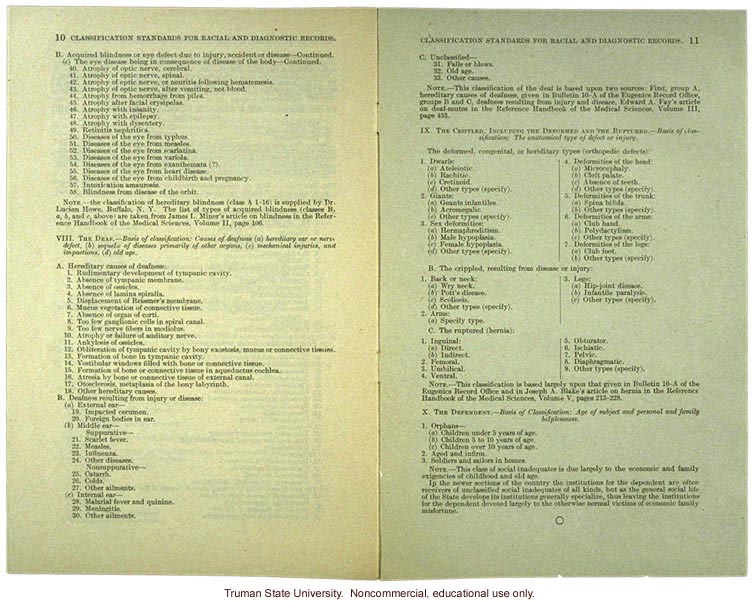10 Classification Standards for Racial and Diagnostic Records.
B. Acquired blindness or eye defect due to injury, accident or disease - Continued.
(c ) The eye disease being in consequence of disease of the body - Continued.
40. Atrophy of the optic nerve, cerebral.
41. Atrophy of the optic nerve, spinal.
42. Atrophy of the optic nerve, or neuritis following hemato[nosis].
43. Atrophy of optic nerve, after vomiting, no blood.
44. Atrophy from hemorrhage from piles.
45. Atrophy after facial [crysipelas].
46. Atrophy with insanity.
47. Atrophy with epilepsy.
48. Atrophy with dysentery.
49. Retinitis nephretica.
50. Disease of the eye from typhus.
51. Diseases of the eye from measles.
52. Diseases of the eye from scarlatina.
53. Diseases of the eye from [variola].
54. Diseases of the eye from exanthemata.
55. Diseases of the eye from heart disease.
56. Diseases of the eye from childbirth and pregnancy.
57. Intoxication [amaurosis].
58. Blindness from disease of the orbit.
Note.-the classification of hereditary blindness (class A 1-16) by Dr. Lucien Howe, Buffalo, N. Y. The list of types of acquired blindness (classes B, a, b, and c, above are taken from James L. Minor's article on blindness in the Reference Handbook of the Medical Sciences, Volume II, page [106].
VIII. The Deaf. -Basis of classification; Causes of deafness (a) hereditary ear or nerve defect; (b) [sequels] of diseases primarily of other organs; (c )mechanical injuries, and [illegible]; (d) old age.
A. Hereditary causes of deafness:
1. Rudimentary development of the tympanic cavity.
2. Absence of tympanic membrane.
3. Absence of [illegible].
4. Absence of lamina spiralis.
5. Displacement of [illegible]'s membrane.
6. Mucus vegetation of connective tissue.
7. Absence of organ of corti.
8. Too few ganglionic cells in spiral canal.
9. Too few nerve fibers in [mediolus].
10. Atrophy or failure of auditory nerve.
11. Ankylosis of ossicles.
12. Obliteration of tympanic cavity by bony [illegible], mucus or connective tissue.
13. Formation of bone in tympanic cavity.
14. Vestibular windows filled with bone or connective tissue.
15. Formation of bone or connective tissue in aqueductus cochlea.
16. Atresia by bone or connective tissue of external canal.
17. Otiosclerosis, neoplasia of the bony labyrinth.
18. Other hereditary causes.
B. Deafness resulting from injury or disease.
(a) External ear-
19. Impacted cerumen.
20. Foreign bodies in ear.
(b) Middle ear-
Suppurative -
21. Scarlet fever.
22. Measles.
23. Influenza.
24. Other diseases.
Non-suppurative -
25. [Catarrh].
26. Colds.
27. Other ailments.
(c ) Internal ear-
28. Malarial fever and quinine.
29. Meningitis.
30. Other ailments.
[right side of spread]
Classification of Standards for Racial and Diagnostic Records. 11
C. Unclassified-
31. Falls or blows.
32. Old age.
33. Other causes.
Note. - This classification of the deaf is based upon two sources. First, group A, hereditary causes of deafness, given in Bulletin [10]-A of the Eugenics Record Office, groups B and C, deafness resulting from injury and disease, Edward A. Fay's article on deaf-mute in the Reference Handbook of the Medical Sciences, Volume III, page [453].
IX. The Crippled, including the Deformed and the Ruptured. - Basis of classification: The anatomical type of defect or injury:
The deformed, congenital, or hereditary types (orthopedic defects):
1. Dwarfs:
(a) [Ateleiotic]
(b) [Rachitic]
(c) Cretinoid.
(d) Other types (specify).
2. Giants:
(a) [Geants] infantiles.
(b) [Acromegalic]
(c) Other types (specify).
3. Sex deformities:
(a) Hermaphroditism.
(b) Male hypoplasia.
(c) Female hypoplasia.
(d) Other types (specify).
4. Deformities of the head:
(a) Microcephaly.
(b) Cleft Palate.
(c) Absence of teeth.
(d) Other types (specify).
5. Deformities of the trunk:
(a) Spina bifida.
(b) Other types (specify).
6. Deformities of the arms:
(a) Club hand.
(b) Polydactylism.
(c) Other types (specify).
7. Deformities of the legs:
(a) Club foot.
(b) Other types (specify).
B. The crippled, resulting from disease of injury:
1. Back or neck:
(a) Wry neck.
(b) Pott's disease.
(c) Scoliosis.
(d) Other types (specify).
2. Arms:
(a) Specify type.
3. Legs:
(a) Hip-joint disease.
(b) Infantile paralysis.
(c) Other types (specify).
C. The ruptured (hernia):
1. Inguinal:
(a) Direct.
(b) Indirect.
2. Femoral.
3. Umbilical.
4. Ventral.
5. Obdurate.
6. Ischiatic.
7. Pelvic.
8. Diaphragmatic.
9. Other types (specify).
Note. - This classification is based largely upon that given in Bulletin [20-A] of the Eugenics Record Office and in Joseph A. Blake's article on hernia in the Reference Handbook of the Medical Sciences, Volume V, pages 213-228.
X. The Dependent. - Basis of Clasification: Age of subject and personal and family helplessness.
1. Orphans -
(a) Children under 5 years of age.
(b) Children 5 to 10 years of age.
(c) Children over 10 years of age.
2. Aged and infirm.
3. Soldiers and sailors in homes.
Note. - This class of social inadequates is due largely to the economic and family exigencies of childhood and old age.
In the newer sections of the country, the institutions for the dependent are often receivers of unclassified social inadequates of all kinds, but as the general social life of the State develops its institutions generally specialize, thus having the institutions for the dependent devoted largely to the otherwise normal victims of economic family misfortune.


